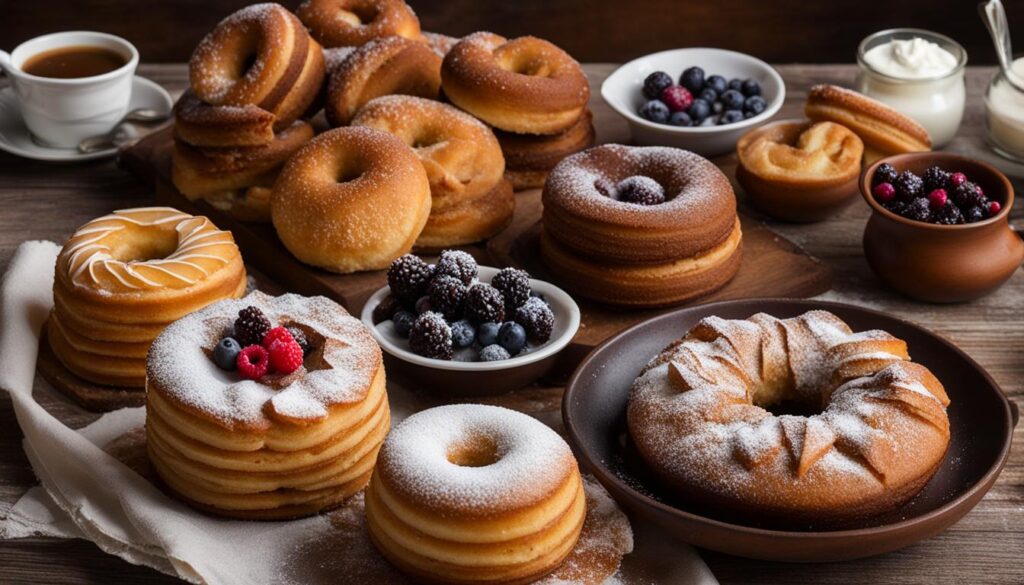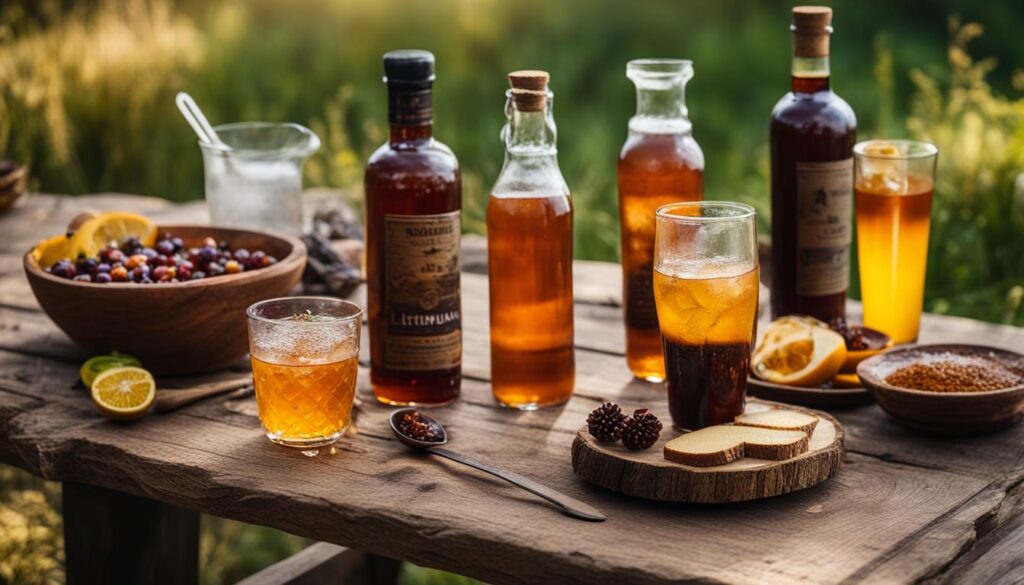Lithuania, with its rich culinary heritage, offers a tantalizing array of traditional food and drink. As a country deeply rooted in history and cultural traditions, Lithuanian cuisine reflects a unique blend of influences from neighboring countries and local ingredients. From savory dishes like Cepelinai and Kibinai to delightful desserts and authentic drinks, Lithuanian culinary offerings are sure to satisfy even the most discerning palate.
When it comes to Lithuanian cuisine, you can expect to find a wide variety of flavors and ingredients that highlight the country’s food culture. Traditional Lithuanian recipes often feature hearty and filling dishes, perfect for the cold climate of the region. Potatoes, rye bread, and wild mushrooms are some of the staples used in many traditional recipes.
Authentic Lithuanian food is a celebration of flavors and textures. From the savory and filling Cepelinai, which are potato dumplings filled with meat or curd cheese, to the aromatic and flaky Kibinai, Lithuanian dishes are a testament to the country’s culinary prowess. These dishes have been passed down through generations, preserving the country’s food heritage.
No Lithuanian meal is complete without a delightful dessert. Traditional Lithuanian desserts like Tinginys, a chocolate and biscuit cake, and Tree Cake, a unique cake cooked on a rotating spit, offer a sweet ending to any meal. Cranberry Pap and Gira or Kvas, both refreshing drinks, are also popular traditional treats in Lithuania.
As you indulge in the traditional food and drink of Lithuania, you’ll discover the rich culinary heritage of the country. The resilience and resourcefulness of the Lithuanian people are evident in their flavorful dishes and diverse ingredients. Exploring Lithuanian cuisine is a journey for your taste buds that you won’t want to miss.
Key Takeaways:
- Lithuanian cuisine showcases a unique blend of influences from neighboring countries and local ingredients.
- Traditional Lithuanian dishes include Cepelinai, Kibinai, Fried Bread Sticks, Cold Beetroot Soup, and Potato Sausage.
- Delightful Lithuanian desserts like Tinginys and Tree Cake offer a sweet ending to any meal.
- Authentic Lithuanian drinks include Cranberry Pap and Gira or Kvas, offering a refreshing taste of Lithuania.
- Exploring the traditional food and drink of Lithuania is a journey into the country’s rich culinary heritage.
Must-Try Traditional Lithuanian Dishes
When it comes to Lithuanian cuisine, there are several traditional dishes that are a must-try for any food lover. These dishes not only showcase the rich culinary heritage of Lithuania but also offer a unique and delicious taste experience.
One of the most popular traditional Lithuanian dishes is Cepelinai. These potato dumplings are filled with either meat or curd cheese and are often served with sour cream and bacon. The combination of the soft and pillowy potato dumplings with the flavorful filling creates a truly satisfying dish.
Another must-try dish is Kibinai, savory pastries filled with various ingredients such as meat, cheese, or vegetables. These pastries are perfect for a quick and tasty snack or as a main course. They are often served hot and are a favorite among locals and visitors alike.
Aside from Cepelinai and Kibinai, there are other popular Lithuanian dishes worth exploring. Fried Bread Sticks, also known as Kepta Duona, are a delicious and crispy snack that pairs well with beer. Cold Beetroot Soup, known as Saltibarsciai, is a refreshing dish made with beets, cucumbers, and sour cream. Potato Sausage, or Bulviniai Vyniotiniai, is a sausage made from grated potatoes and filled with meat.
Discover the flavors of Lithuania
These traditional Lithuanian dishes not only represent the country’s culinary heritage but also offer a glimpse into its culture and traditions. The flavors and ingredients used in these dishes are a testament to Lithuania’s rich history and geographical location.
So, if you’re looking to embark on a culinary adventure, be sure to try these must-try traditional Lithuanian dishes. They will take your taste buds on a journey through the vibrant flavors and unique aromas of Lithuania, leaving you craving for more.
Delightful Lithuanian Desserts

When it comes to satisfying your sweet tooth, Lithuanian desserts offer a delightful array of flavors and textures. These traditional Lithuanian recipes are a testament to the country’s rich culinary heritage, showcasing the creativity and sweetness that define Lithuanian cuisine.
One must-try Lithuanian dessert is Tinginys, a chocolate and biscuit cake. This indulgent treat is made by mixing crushed biscuits and condensed milk with cocoa powder, creating a rich and creamy dessert that is beloved by locals. The combination of chocolate and biscuits makes Tinginys a perfect choice for any chocolate lover.
Another unique Lithuanian dessert is Tree Cake, also known as Šakotis. This whimsical cake is cooked on a rotating spit, resulting in a distinctive shape resembling the branches of a tree. The layers of cake are crispy on the outside and soft on the inside, creating a delightful contrast of textures. Tree Cake is often enjoyed during special occasions and celebrations.
In addition to cakes, Lithuanian desserts also include refreshing drinks. Cranberry Pap, a cranberry-based drink, provides a tangy and refreshing taste. Made by boiling cranberries with sugar, this drink is perfect for quenching your thirst on a hot summer day. Gira or Kvas, a fermented bread-based drink, is another popular choice. Its slightly sweet and sour flavor makes it a unique and enjoyable beverage.
Indulge in Lithuania’s Sweet Delights
Lithuanian desserts offer a delightful variety of flavors and textures, capturing the essence of the country’s culinary heritage. From the rich and creamy Tinginys to the whimsical Tree Cake, these desserts showcase the creativity and sweetness that define Lithuanian cuisine. Whether you’re looking for a decadent dessert or a refreshing drink, Lithuanian desserts have something to satisfy every sweet craving.
Authentic Lithuanian Drinks

In addition to the delicious food, Lithuania is also known for its variety of traditional drinks that perfectly complement the culinary experience. These authentic Lithuanian drinks are not only refreshing but also offer a taste of the country’s rich culinary heritage.
One popular traditional Lithuanian drink is Cranberry Pap, a thick and flavorful cranberry beverage. This refreshing drink is especially enjoyed during the summer months when cranberries are in season. It’s the perfect way to quench your thirst and indulge in the natural sweetness of this traditional Lithuanian drink.
Another unique Lithuanian drink is Gira or Kvas, a fermented bread beverage that has a slightly sweet flavor. This traditional drink is made by boiling bread in water and fermenting it, resulting in a tangy and fizzy drink that is truly one-of-a-kind. Gira or Kvas is often enjoyed alongside traditional Lithuanian dishes, as it complements the flavors and adds a refreshing element to the meal.
These authentic Lithuanian drinks not only showcase the country’s culinary heritage but also provide a delightful and unique taste experience. Whether you’re sipping on Cranberry Pap or savoring a glass of Gira or Kvas, you’ll be transported to the heart of Lithuania and its rich culinary traditions.
The Culinary Heritage of Lithuania
Lithuania’s culinary heritage is a reflection of its rich history and cultural traditions. Influenced by neighboring countries like Poland, Russia, and Germany, Lithuanian cuisine has evolved into a unique blend of flavors and ingredients. The traditional Lithuanian recipes showcase the country’s resourcefulness and resilience throughout its past.
The heartiness and filling nature of traditional Lithuanian dishes are well-suited to the country’s cold climate. Potatoes, rye bread, and wild mushrooms are staple ingredients in many Lithuanian recipes, adding depth and flavor to the dishes. These recipes have been passed down through generations, preserving the country’s culinary traditions and keeping them alive for future generations to enjoy.
Lithuanian Food Culture
Lithuanian food culture is deeply rooted in the traditions of gathering and sharing meals with family and friends. Food plays an important role in celebrations and social gatherings, bringing people together and creating a sense of community. Traditional Lithuanian recipes are often prepared with love and care, using locally sourced ingredients and traditional cooking methods. This emphasis on quality and authenticity is what makes Lithuanian cuisine truly special.
Exploring the traditional food and drink of Lithuania is a journey that will tantalize your taste buds and offer a unique culinary experience. From the savory delights of Cepelinai and Kibinai to the sweet treats of Tinginys and Tree Cake, each dish tells a story and reflects the cultural heritage of the country. Whether you’re a food lover or simply curious about trying new flavors, don’t miss the opportunity to savor the traditional dishes and beverages that have been cherished by Lithuanians for centuries.
The Resilience of Lithuanian Cuisine
The culinary heritage of Lithuania is a testament to the resilience and adaptability of its people. Over the centuries, Lithuania has faced various challenges, including invasions and occupations. However, the country’s culinary traditions have remained strong, providing comfort and sustenance during difficult times. The traditional recipes that have been passed down through generations continue to be a source of pride and identity for the Lithuanian people.
Lithuanian cuisine is more than just food and drink; it is a symbol of cultural heritage and a connection to the past. By embracing and celebrating their culinary traditions, Lithuanians preserve their unique identity and share their rich culture with the world. So, take a culinary journey to Lithuania and experience the flavors and traditions that have shaped this remarkable country.
Conclusion
In conclusion, the traditional food and drink of Lithuania offer a delightful culinary experience that showcases the country’s rich heritage. Iconic dishes like Cepelinai and Kibinai are must-tries, with their unique flavors and ingredients. These dishes, along with the delightful Lithuanian desserts and authentic drinks, provide a true taste of Lithuanian cuisine.
Lithuanian cuisine is a blend of influences from neighboring countries, such as Poland, Russia, and Germany, as well as local ingredients like potatoes, rye bread, and wild mushrooms. The culinary heritage of Lithuania reflects the resilience and resourcefulness of its people throughout history, creating hearty and filling dishes perfect for the country’s cold climate.
Whether you’re a food lover or simply curious about exploring new flavors, don’t miss the opportunity to sample the traditional food and drink of Lithuania. The mouthwatering culinary delights will take your taste buds on a journey and provide a unique experience. So, indulge in the Traditional Food and Drink Of Lithuania, and immerse yourself in the flavors of Lithuanian cuisine.
Other Related Articles
-
Traditional Food and Drink Of Estonia
-
Traditional Food and Drink Of Ireland
-
Traditional Food and Drink of Finland
-
Traditional Food and Drink Of Lithuania
-
Traditional Food and Drink Of Latvia
-
Exploring Past and Present Diets of Finland
-
Exploring Past and Present Diets of Ireland
-
Exploring Past and Present Diets of Estonia
FAQ
What are some traditional Lithuanian dishes to try?
Some must-try traditional Lithuanian dishes include Cepelinai (potato dumplings filled with meat or curd cheese), Kibinai (savory pastries filled with various ingredients), Fried Bread Sticks, Cold Beetroot Soup, and Potato Sausage.
What are some traditional Lithuanian desserts?
Traditional Lithuanian desserts include Tinginys (a chocolate and biscuit cake), Tree Cake (a unique cake cooked on a rotating spit), Cranberry Pap (a refreshing cranberry drink), and Gira or Kvas (a bread-based drink).
What are some traditional Lithuanian drinks?
Some traditional Lithuanian drinks include Cranberry Pap (a thick cranberry drink) and Gira or Kvas (a fermented bread drink).
What is the culinary heritage of Lithuania?
The culinary heritage of Lithuania combines influences from neighboring countries such as Poland, Russia, and Germany, while also incorporating local ingredients like potatoes, rye bread, and wild mushrooms.



